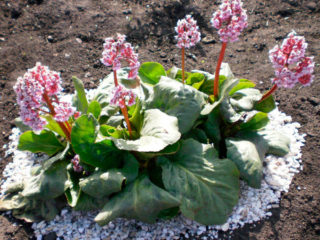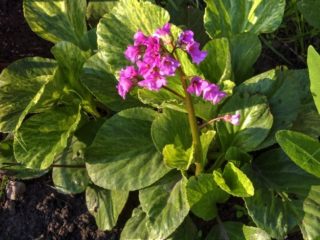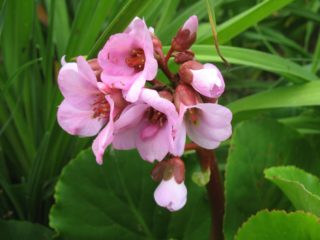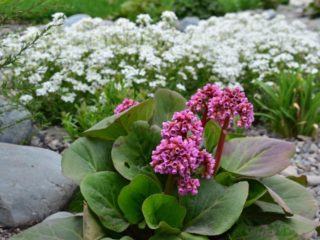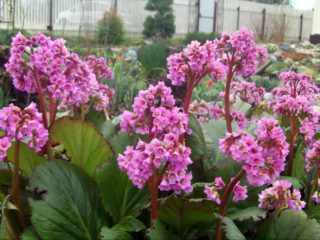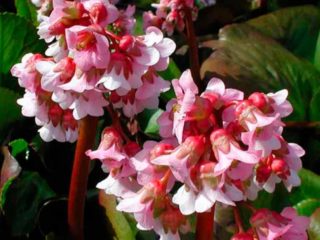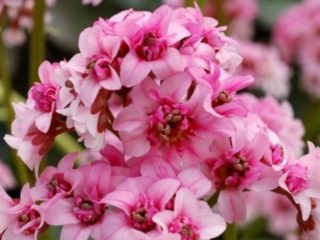Content
Badan does not bloom on the site for a number of serious reasons that need to be disassembled separately. Most often, the problem lies in the care of the plant. This perennial is considered an unpretentious culture, but certain skills and experience with it are required.
Why does badan not bloom

Badan looks very harmonious against the background of stones
Badan is a perennial herb. It belongs to the class of dicotyledonous crops, so it has the following characteristics:
- pivotal root system;
- two cotyledons per seed;
- leaf plates on petioles;
- perianth double;
- leaf venation is reticulate;
- flowers have five petals.
Badan in natural conditions is common in the temperate zone of the Northern Hemisphere. The plant can be found in Central Asia, Altai, Siberia, Primorsky Territory and Kazakhstan. In the east, the range of badan extends to the PRC and Mongolia. The culture prefers to multiply and grow on rocks, mountain slopes, embankments, forest edges.
Today the plant has several varieties and hybrids. Some of them are popular with gardeners. It is irreplaceable in landscape design. Its pink flowers look especially beautiful on a rocky background next to phlox and hosta.
Badan is a rather unpretentious plant, but novice gardeners sometimes face some problems. One of them is the lack of flowering. There are many reasons for this, but they are easy to deal with.
Poor growing conditions
Experienced gardeners include poor growing conditions:
- frequent transfer from one place to another;
- lack of lighting;
- little room for development and growth;
- incorrectly selected area.
These "misses" in containment need to be considered in more detail.
Comment! Badan is widely used in folk medicine, but not all varieties, but only thick-leaved. It is called medicinal. The rhizome, which contains tannins, is considered curative.
The plant has anti-inflammatory, hemostatic and antibacterial properties.
Badan sometimes does not bloom, because it does not have time to take root and adapt, since the bush is transplanted from place to place. It is extremely difficult for him to endure the transplantation procedure, and it does not matter whether we are talking about an adult, formed plant, or about a part of the rhizome during reproduction. Often, the culture not only does not bloom for a long time, but also gets sick for a period after transplantation. The solution to the problem is as follows: plan the landing site in advance, having thought over all the details, and also give the badan the opportunity to settle down in a new place.
Badan grows well and develops in low light, but it will hardly bloom at the same time. The plant loves the sun's rays, but scattered, not direct. It is especially uncomfortable for him under a spreading tree with a large crown.
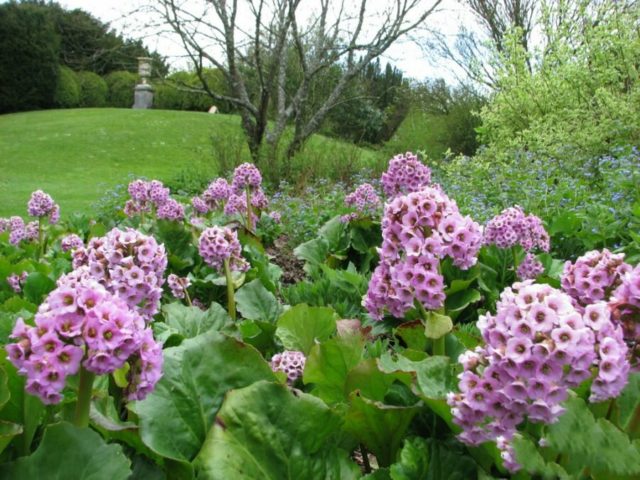
Badan is actively used in landscape design, in open areas
Flowering may be delayed or not at all due to densely planted plants. This is often observed when planting perennials in rows. Over time, they grow and interfere with each other's development. In this case, flowering is out of the question.
Thus, the berry planting site plays a huge role for a beautiful flowering. It should be taken care of long before disembarkation and the pros and cons should be weighed.
Improper care
To achieve development, flowering from badan, and from any other plant, you will need to know the basics of competent care, despite the unpretentiousness of the culture. Proper care includes the following necessary procedures:
- watering;
- mulching;
- top dressing;
- removal of old leaves;
- preparation for the winter season.
Badan care is simple. After the snow melts, the plant must be inspected and damaged, dry and rotten leaf plates removed. After pruning, the crop can be fed. The first feeding is done at the very beginning of spring, and the second after the end of flowering.
Moistening should be done as needed. For example, before the flowering period, at the time of bud formation, watering should be abundant if the weather is dry. Then it should be watered at the beginning of flowering and after 15-20 days. However, if the weather is humid, it rains periodically, then abundant watering of the plant is not required.
The lower leaves protect the root system from drying out. As they fall, leave them on the soil to retain moisture. Old leaves of the berry cannot be cut off, they are carefully plucked without leaving cuttings. This procedure is carried out in the fall.
Preparation for wintering will be required for young, immature plants. Usually they are covered with spruce branches, old dry foliage, and this procedure is not needed for frost-resistant varieties.
The bush is propagated by cuttings or seeds. The seeds are black, very small, and during development the seedlings require care and constant monitoring. Special skill is needed when diving. At the same time, flowering does not come soon. It is easier to propagate berserk by cuttings. This requires large and healthy adult bushes. Rooting can be noticed after a few days.
With proper care and maintenance, a banana will bloom regularly.
Diseases and pests
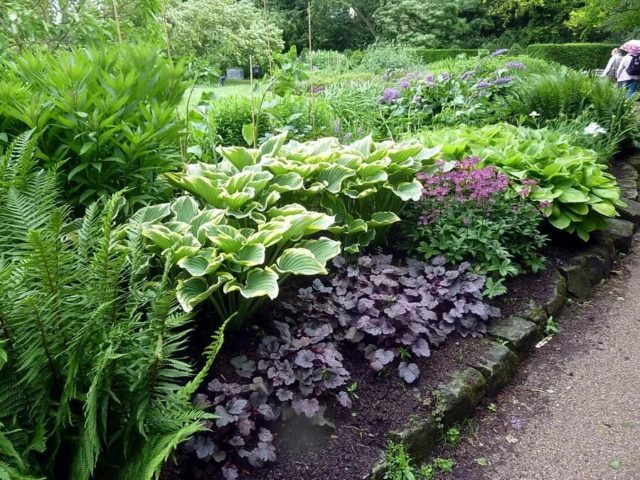
Blooming badan successfully adjoins next to the host
If the berry does not bloom, it is necessary to inspect the plant for diseases and insect pests. The culture is resistant to various diseases, but with poor care, the plant weakens and a certain spotting appears on the leaves. Dark spots cover the leaf plate from the outside, and white bloom is observed on the opposite side. For treatment, you will need to remove all affected leaves, and then proceed with the treatment with Bordeaux liquid, foundationol or other preparations containing copper. Of course, while the culture is sick, flowering does not occur.
Badan can infect the following types of pests:
- nematode;
- slobbering penny.
A nematoda is a small worm that lives in the ground. The parasite lays ball-shaped larvae. It is characterized by rapid reproduction. The situation can be corrected by transplanting the culture to another place, while removing part of the affected root system. The soil must be treated with special preparations and nothing should be planted in this place for about a year.
Pennitsa annoys a plant if it grows in shaded areas with excess moisture. The insect produces saliva, which contains the larvae. Badan becomes covered with this mucus and begins to rot. For the treatment of the culture from the penny, there are drugs such as Tsvetofos and Intavir.
What other reasons could there be
Sometimes berry does not bloom for reasons beyond the control of the gardener. This includes the age of the plant and its origin. If the culture is quite young and grew from seeds, then it has a slowed down development of seedlings, especially in the early years. She needs to wait a little, gain strength and then, subject to proper care, flowering will be annual and in full.
When badan blooms poorly, it is recommended to measure the pH of the soil - it should be neutral. In the event that the soil is acidic, this can be corrected with garden lime.
Despite the fact that the culture is frost-resistant, it should be covered for the winter. Often the reason lies in the lack of heat, especially if the winter did not please with snow.
What to do if incense does not bloom
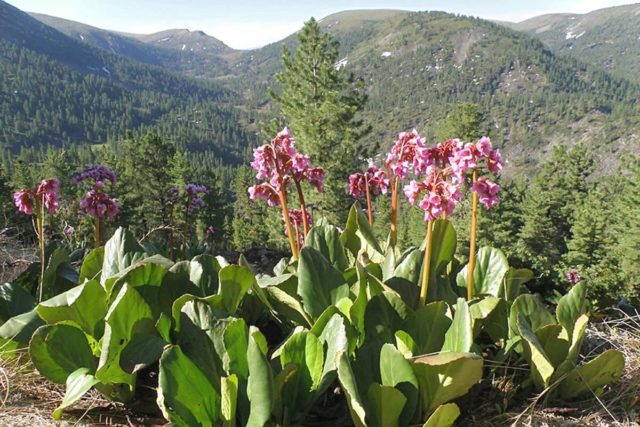
Thick-leaved incense has medicinal properties
If the berry does not bloom, you do not need to despair, it may need time to adapt after a recent transplant. A plant that has grown from seed will take a long time to prepare for flowering. Sometimes it takes about 3-4 years.
It is also worth checking the crop for pests and disease. You shouldn't be afraid of these problems either. In most cases, all diseases are treatable with special drugs.
It is imperative to make sure that the bush is located on the site correctly, taking into account the natural needs of this culture. You should know that badan does not tolerate the north side, excessive moisture and strong shade. It is also important to understand that caring for the plant complies with the basic rules and that fertilizing and watering is enough for it, and pruning takes place in a timely manner.
Conclusion
Berry does not bloom for various reasons. In fact, this is one of the few perennials that gardeners love for their simplicity. He has some features that require attention and basic knowledge. With proper care, the culture annually pleases with its flowering.
